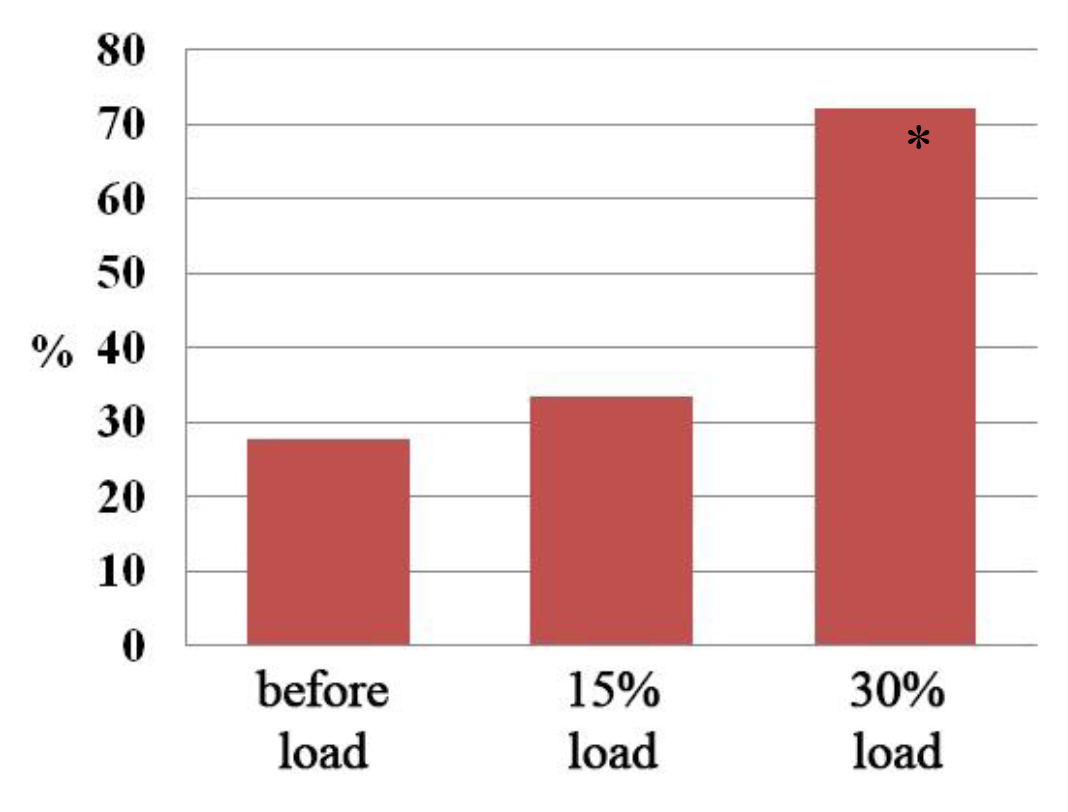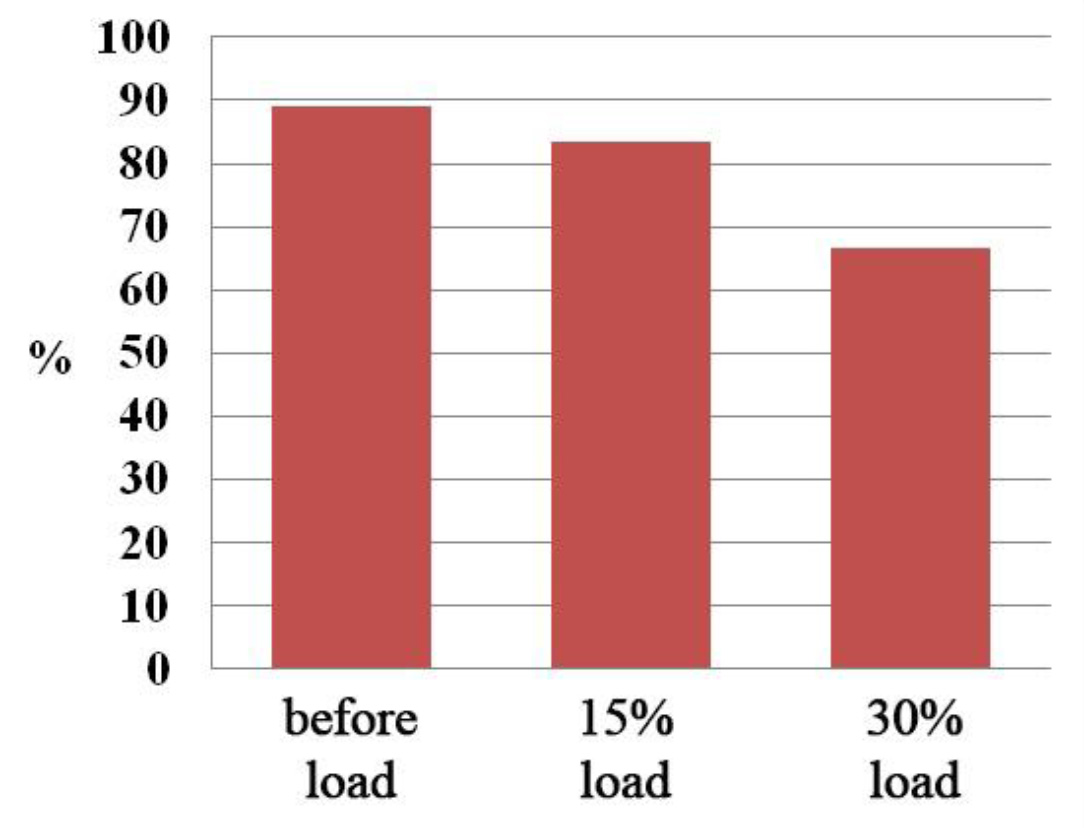Effects of controlled physical activity on cognitive process efficiency
Фотографии:
ˑ:
Postgraduate K.G. Milovanova1
Postdoctoral fellow. PhD Gavin Tempest1
Master's student Y.A.Buel1
PhD A.V. Kabachkova1
Professor, Dr.Med. L.V. Kapilevich1, 2
1National Research Tomsk State University, Tomsk
2National Research Tomsk Polytechnic University, Tomsk
Keywords: physical loads, cognitive abilities, mental arithmetic.
Introduction. Numerous studies have shown that physical loads have a positive impact on man’s mental capacity [1, 3]. It is considered proven that low and short-term physical activities improve efficiency of mental activity, while heavy and long-term ones, on the contrary, negate it. The research analysis in this area has revealed various effects of physical activity on mental capacity. Thus, for instance, an urgent effect on mental activity is observed with the use of different forms of physical education, among which physical training breaks (P.E. breaks) are the most popular. During the P.E. break, the proprioceptive input from the working muscles increases, which activates the brain and, consequently, ensures optimal working capacity [3, 5]. Short-term physical exercises can maintain the high mental capacity rates for a long time, which has been proven in the studies by A.P. Yerastova, T.A. Yerakhtina, V.N. Shcherbinina and others. Whereas a delayed effect of physical exercises on mental capacity is due to the better coherent functioning of various physiological systems of the body. The researchers note that well controlled physical activities (primarily cyclic endurance exercises) enhance the functioning of all the body organs and systems, and tone up the nervous system, which increases the performance level [4, 5]. At the same time, the quantitative characteristics of the effect of physical loads on the cognitive process efficiency are to be defined.
Objective of the study was to analyze the effects of controlled physical activity on the cognitive process efficiency as tested by a mental arithmetic.
Materials and methods. Subject to the study were healthy young right-handed students (n=18) from National Research Tomsk State University (Mean±SD; aged 19.19±1.20 years on average, 182.11±6.00 cm tall on average; and with average body mass of 76.83±10.90 kg). The mental arithmetic tests were performed post meridiem.
Organisation of research. The testee made himself/herself comfortable in an armchair in front of a monitor displaying the dynamometer readings. The study included a controlled dynamometer force at two different load levels, each being coupled with the cognitive test if needed. One attempt lasted 30 seconds, followed by a 30-second rest. Each participant was informed that he/she was to demonstrate the maximum task solving efficiency.
The subjects performed the tasks using a dynamometer, grabbing it with their non-dominant hand. According to Yoon et al. (2009), we chose the non-dominant hand to minimize the variability between the subjects, which might arise due to the differences in their regular daily activities performed by the dominant hand. We used the Edinburgh questionnaire (Oldfield, 1971) to classify the surveyed by the dominant right hand. The task included two stages. At the first stage, the subjects triply performed maximal voluntary contraction (MVC) on the dynamometer (a software complex for psychophysiological and psychological testing with the registration of the vegetative and emotional reactions "NS-Psychotest" by Neurosoft Ltd., Russia), each attempt lasted 5 seconds, rest intervals - 30 seconds. Then, the mean value was calculated, as well as 15% and 30% of the average maximal effort. At the second stage, the subjects were to maintain the required level of force for 30 seconds under two different submaximal loads (15% and 30% MVC) by comparing the scale data displayed on the monitor. Low and moderate load levels (15% and 30% MVC, respectively) were chosen to avoid the restriction of the muscle blood flow, which may in turn cause adverse cerebrovascular reactions due to increased sympathetic activation (Vianna et al., 2012). The left hand was straightened at the elbow by ~180 ° to avoid the effects of any possible compensation during the task.
The proposed cognitive task (mental arithmetic) is a well-known psychological technique used to assess mental load (Critchley et al, 2000; Noteboom et al., 2001.). The subjects were asked to perform a 30-sec mental arithmetic, which consisted of the subsequent of mathematical calculations (the second number was continuously subtracted from the first one, for example: 32 - 7 = ?-7 = ?-7, and so on). There were two difficulty levels of the tasks (low: a one-digit number was subtracted from a two-digit one; high: a three-digit number - from a four-digit one). These tasks were to be fulfilled as quickly and accurately as possible.
The statistical data processing was made using the STATISTICA 8.0 software and implied the determination of the sampling descriptive parameters and comparative analysis of the dependent (X2 McNemar test) samples. P£0.05 was taken as a statistically significant difference.
Results and discussion. Figure 1 displays the results of the low-difficulty cognitive tests without physical load, with the load of 15% and 30% MVC.

Fig. 1. Low-difficulty cognitive test results.
* – significance of differences compared to the result obtained before load (p<0.05)
The analysis has revealed a statistically significant positive trend in the results of the low-difficulty intellectual test under the load of 30% MVC (p=0.02, X2=4.9): when not exposed to physical loads only 27.8% (5/18) of subjects coped successfully with the task, under the load of 30% MVC – 72.2% (13/18); during the test under the load of 15% MVC there is solely a negative trend by contrast with the test with no physical load (p>0.05): under the load of 15% MVC 66.7% (12/18) passed the test. There were the statistically significant differences between the combined test results.
Figure 2 illustrates the results of the high-difficulty intellectual tests without physical load, under the load of 15% and 30% MVC.

Fig. 2. High-difficulty cognitive test results
* - significance of differences compared to the result obtained before load (p<0.05)
The analysis has not revealed any statistically significant differences, however, there is a downward tendency in the high-difficulty intellectual test with the use of physical load of 15% MVC (p=0.38) and 30% MVC (p=0.68): 66.7 % (12/18) of subjects coped with the task without being exposed to physical loads, under the load of 15% MVC – 88.9% (16/18), and under the load of 30% MVC – 83.3% (15/18). There is a negative trend in the combined test results (p>0.05).
Conclusion. Moderate physical loads improve the cognitive process efficiency in the low-difficulty tasks, with the moderate-level loads found to evoke the notably higher positive effects than the low-level ones. The high-difficulty task solving efficiency, on the contrary, goes down after the physical loads with the efficiency sags being proportionate to the load rates. Therefore, the effects of the physical loads on cognitive abilities are equally dependent on the load intensities and difficulty levels of the tasks solved.
References
- Bulich E.V. Fiziologo-gigienicheskaya kharakteristika vliyaniya zanyatiy fizicheskim vospitaniem na umstvennuyu rabotosposobnost i psikhoemotsional'nuyu ustoychivost studentov [Physiological and hygienic characteristics of effect of physical education classes on students' mental capacity and psycho-emotional stability] Uch. zapiski. SSU, 2007.
- Kabachkova A.V., Zakharova A.N., Lalaeva G.S., Kapilevich L.V. Dinamika karotidnogo krovotoka pri vypolnenii kognitivnoy proby pri regulyarnykh fizicheskikh nagruzkakh [Carotid blood flow changes during cognitive test in case of regular physical exercise]. Proc. Sci. Conf. Modern problems of physiological functions regulation system. Moscow: P.K. Anokhin SRINF publ., 2015, pp. 282-285. Available at: http://znanium.com/catalog.php?bookinfo=529611 (In Russ.)
- Lyubaev A.V. Vliyanie fizicheskikh uprazhneniy na umstvennuyu deyatelnost studentov i ikh vzaimosvyaz [Effect of exercises on students' mental performance and their relation]. Molodoy ucheny, 2015, no. 18, pp. 423-425.
- Reyzin V.M. Fizicheskaya kultura lyudey umstvennogo truda [Physical culture of intellectual workers]. Minsk: BSU Publ., 1979, 176 p.
- Starodubtseva I.V. Umstvennoe i fizicheskoe vospitanie: tochki soprikosnoveniya [Mental and physical education: common ground]. Izvestiya Tulskogo gosudarstvennogo universiteta. Gumanitarnyie nauki, 2008, no. 1, pp. 19-21.
- Mandrick K., Derosiere G., Dray G. et al. Prefrontal cortex activity during motor tasks with additional mental load requiring attentional demand: A near-infrared spectroscopy study. Neuroscience Research, 2013, vol. 76, pp. 156–162.
Corresponding author: kapil@yandex.ru
Abstract
Objective of the study was to analyze the effects of controlled physical activity on the cognitive process efficiency as tested by a mental arithmetic. Subject to the study were healthy young right-handed students (n=18) from National Research Tomsk State University (Mean ±SD; aged 19.19±1.20 years on average, 182.11±6.00 cm tall on average; and with average body mass of 76.83±10.90 kg). The mental arithmetic tests were performed post meridiem.
The study showed the moderate physical loads being of positive effect on the cognitive process efficiency in low-difficulty tasks, with the moderate-level loads found to evoke the notably higher positive effects than the low-level ones. The high-difficulty task solving efficiency, on the contrary, was found to go down after the physical loads with the efficiency sags being proportionate to the load rates. Therefore, it may be concluded that the effects of physical loads on cognitive abilities are equally dependent on the load intensities and difficulty levels of the tasks solved.




